Quantification of the Spatial Heterogeneity of PM2.5 to Support the Evaluation of Low-Cost Sensors: A Long-Term Urban Case Study
Abstract
1. Introduction
2. Materials and Methods
2.1. Air Quality Monitors Used for Indoor Measurements
2.2. Description of the Measurement Sites
2.3. Hungarian Air Quality Monitoring Stations
2.4. Data Processing
2.4.1. Long-Term Indoor Air Quality Measurement Data
2.4.2. Detection of Ventilation
2.4.3. Determining the Homogeneity/Heterogeneity of Outdoor PM2.5
2.4.4. Statistical Analysis
3. Results and Discussion
3.1. Long-Term Indoor and Outdoor PM2.5 Concentration
3.2. Results of Ventilation Detection
3.3. Spatial Variability of PM2.5 Concentration
3.4. Algorithm to Identify Homogeneity Threshold Applicable to the LCS Evaluation
3.5. Evaluation of the LCSs Using Ventilation Events
4. Conclusions
Supplementary Materials
Author Contributions
Funding
Institutional Review Board Statement
Informed Consent Statement
Data Availability Statement
Acknowledgments
Conflicts of Interest
References
- Chen, C.; Zhao, B. Review of Relationship between Indoor and Outdoor Particles: I/O Ratio, Infiltration Factor and Penetration Factor. Atmos. Environ. 2011, 45, 275–288. [Google Scholar] [CrossRef]
- Leung, D.Y.C. Outdoor-Indoor Air Pollution in Urban Environment: Challenges and Opportunity. Front. Environ. Sci. 2015, 2, 69. [Google Scholar] [CrossRef]
- Hoskins, J.A. Health Effects Due to Indoor Air Pollution. Indoor Built Environ. 2003, 12, 427–433. [Google Scholar] [CrossRef]
- Tran, V.V.; Park, D.; Lee, Y.-C. Indoor Air Pollution, Related Human Diseases, and Recent Trends in the Control and Improvement of Indoor Air Quality. Int. J. Environ. Res. Public Health 2020, 17, 2927. [Google Scholar] [CrossRef]
- Schweizer, C.; Edwards, R.D.; Bayer-Oglesby, L.; Gauderman, W.J.; Ilacqua, V.; Jantunen, M.J.; Lai, H.K.; Nieuwenhuijsen, M.; Künzli, N. Indoor Time-Microenvironment-Activity Patterns in Seven Regions of Europe. J. Expo. Sci. Environ. Epidemiol. 2007, 17, 170–181. [Google Scholar] [CrossRef]
- Klepeis, N.E.; Nelson, W.C.; Ott, W.R.; Robinson, J.P.; Tsang, A.M.; Switzer, P.; Behar, J.V.; Hern, S.C.; Engelmann, W.H. The National Human Activity Pattern Survey (NHAPS): A Resource for Assessing Exposure to Environmental Pollutants. J. Expo. Sci. Environ. Epidemiol. 2001, 11, 231–252. [Google Scholar] [CrossRef]
- Al-Kindi, S.G.; Brook, R.D.; Biswal, S.; Rajagopalan, S. Environmental Determinants of Cardiovascular Disease: Lessons Learned from Air Pollution. Nat. Rev. Cardiol. 2020, 17, 656–672. [Google Scholar] [CrossRef]
- Ezzati, M.; Kammen, D.M. Quantifying the Effects of Exposure to Indoor Air Pollution from Biomass Combustion on Acute Respiratory Infections in Developing Countries. Environ. Health Perspect. 2001, 109, 481–488. [Google Scholar] [CrossRef]
- Sarigiannis, D.A.; Karakitsios, S.P.; Gotti, A.; Liakos, I.L.; Katsoyiannis, A. Exposure to Major Volatile Organic Compounds and Carbonyls in European Indoor Environments and Associated Health Risk. Environ. Int. 2011, 37, 743–765. [Google Scholar] [CrossRef]
- Shetty, B.S.P.; D’Souza, G.; Padukudru Anand, M. Effect of Indoor Air Pollution on Chronic Obstructive Pulmonary Disease (COPD) Deaths in Southern Asia—A Systematic Review and Meta-Analysis. Toxics 2021, 9, 85. [Google Scholar] [CrossRef]
- Vardoulakis, S.; Giagloglou, E.; Steinle, S.; Davis, A.; Sleeuwenhoek, A.; Galea, K.S.; Dixon, K.; Crawford, J.O. Indoor Exposure to Selected Air Pollutants in the Home Environment: A Systematic Review. Int. J. Environ. Res. Public Health 2020, 17, 8972. [Google Scholar] [CrossRef] [PubMed]
- Ferenczi, Z.; Imre, K.; Lakatos, M.; Molnár, Á.; Bozó, L.; Homolya, E.; Gelencsér, A. Long-Term Characterization of Urban PM10 in Hungary. Aerosol Air Qual. Res. 2021, 21, 210048. [Google Scholar] [CrossRef]
- Molnár, A.; Imre, K.; Ferenczi, Z.; Kiss, G.; Gelencsér, A. Aerosol Hygroscopicity: Hygroscopic Growth Proxy Based on Visibility for Low-Cost PM Monitoring. Atmos. Res. 2020, 236, 104815. [Google Scholar] [CrossRef]
- Qor-el-aine, A.; Béres, A.; Géczi, G. Calibration of CAMS PM2.5 Data over Hungary: A Machine Learning Approach. Environ. Res. Commun. 2024, 6, 075026. [Google Scholar] [CrossRef]
- Varga-Balogh, A.; Leelőssy, Á.; Mészáros, R. Effects of COVID-Induced Mobility Restrictions and Weather Conditions on Air Quality in Hungary. Atmosphere 2021, 12, 561. [Google Scholar] [CrossRef]
- Varga-Balogh, A.; Leelőssy, Á.; Lagzi, I.; Mészáros, R. Time-Dependent Downscaling of PM2.5 Predictions from CAMS Air Quality Models to Urban Monitoring Sites in Budapest. Atmosphere 2020, 11, 669. [Google Scholar] [CrossRef]
- Szabados, M.; Magyar, D.; Tischner, Z.; Szigeti, T. Indoor Air Quality in Hungarian Passive Houses. Atmos. Environ. 2023, 307, 119857. [Google Scholar] [CrossRef]
- Szabados, M.; Kakucs, R.; Páldy, A.; Kotlík, B.; Kazmarová, H.; Dongiovanni, A.; Di Maggio, A.; Kozajda, A.; Jutraz, A.; Kukec, A.; et al. Association of Parent-Reported Health Symptoms with Indoor Air Quality in Primary School Buildings—The InAirQ Study. Build. Environ. 2022, 221, 109339. [Google Scholar] [CrossRef]
- Szabados, M.; Csákó, Z.; Kotlík, B.; Kazmarová, H.; Kozajda, A.; Jutraz, A.; Kukec, A.; Otorepec, P.; Dongiovanni, A.; Di Maggio, A.; et al. Indoor Air Quality and the Associated Health Risk in Primary School Buildings in Central Europe—The InAirQ Study. Indoor Air 2021, 31, 989–1003. [Google Scholar] [CrossRef]
- Hassani, A.; Salamalikis, V.; Schneider, P.; Stebel, K.; Castell, N. A Scalable Framework for Harmonizing, Standardization, and Correcting Crowd-Sourced Low-Cost Sensor PM2.5 Data across Europe. J. Environ. Manag. 2025, 380, 125100. [Google Scholar] [CrossRef] [PubMed]
- Anastasiou, E.; Vilcassim, M.J.R.; Adragna, J.; Gill, E.; Tovar, A.; Thorpe, L.E.; Gordon, T. Feasibility of Low-Cost Particle Sensor Types in Long-Term Indoor Air Pollution Health Studies after Repeated Calibration, 2019–2021. Sci. Rep. 2022, 12, 14571. [Google Scholar] [CrossRef]
- Demanega, I.; Mujan, I.; Singer, B.C.; Anđelković, A.S.; Babich, F.; Licina, D. Performance Assessment of Low-Cost Environmental Monitors and Single Sensors under Variable Indoor Air Quality and Thermal Conditions. Build. Environ. 2021, 187, 107415. [Google Scholar] [CrossRef]
- Kim, D.; Yum, Y.; George, K.; Kwon, J.-W.; Kim, W.K.; Baek, H.-S.; Suh, D.I.; Yang, H.-J.; Yoo, Y.; Yu, J.; et al. Real-Time Low-Cost Personal Monitoring for Exposure to PM2.5 among Asthmatic Children: Opportunities and Challenges. Atmosphere 2021, 12, 1192. [Google Scholar] [CrossRef]
- Sá, J.P.; Chojer, H.; Branco, P.T.B.S.; Forstmaier, A.; Alvim-Ferraz, M.C.M.; Martins, F.G.; Sousa, S.I.V. Selection and Evaluation of Commercial Low-Cost Devices for Indoor Air Quality Monitoring in Schools. J. Build. Eng. 2024, 98, 110952. [Google Scholar] [CrossRef]
- Connolly, R.E.; Yu, Q.; Wang, Z.; Chen, Y.-H.; Liu, J.Z.; Collier-Oxandale, A.; Papapostolou, V.; Polidori, A.; Zhu, Y. Long-Term Evaluation of a Low-Cost Air Sensor Network for Monitoring Indoor and Outdoor Air Quality at the Community Scale. Sci. Total Environ. 2022, 807, 150797. [Google Scholar] [CrossRef]
- Zamora, M.L.; Rice, J.; Koehler, K. One Year Evaluation of Three Low-Cost PM2.5 Monitors. Atmos. Environ. 2020, 235, 117615. [Google Scholar] [CrossRef]
- Ródenas García, M.; Spinazzé, A.; Branco, P.T.B.S.; Borghi, F.; Villena, G.; Cattaneo, A.; Di Gilio, A.; Mihucz, V.G.; Gómez Álvarez, E.; Lopes, S.I.; et al. Review of Low-Cost Sensors for Indoor Air Quality: Features and Applications. Appl. Spectrosc. Rev. 2022, 57, 747–779. [Google Scholar] [CrossRef]
- Atfeh, B.; Barcza, Z.; Groma, V.; Tordai, Á.V.; Mészáros, R. Performance Assessment of Low- and Medium-Cost PM2.5 Sensors in Real-World Conditions in Central Europe. Atmosphere 2025, 16, 796. [Google Scholar] [CrossRef]
- Castell, N.; Dauge, F.R.; Schneider, P.; Vogt, M.; Lerner, U.; Fishbain, B.; Broday, D.; Bartonova, A. Can Commercial Low-Cost Sensor Platforms Contribute to Air Quality Monitoring and Exposure Estimates? Environ. Int. 2017, 99, 293–302. [Google Scholar] [CrossRef]
- Feenstra, B.; Papapostolou, V.; Hasheminassab, S.; Zhang, H.; Boghossian, B.D.; Cocker, D.; Polidori, A. Performance Evaluation of Twelve Low-Cost PM2.5 Sensors at an Ambient Air Monitoring Site. Atmos. Environ. 2019, 216, 116946. [Google Scholar] [CrossRef]
- Karagulian, F.; Barbiere, M.; Kotsev, A.; Spinelle, L.; Gerboles, M.; Lagler, F.; Redon, N.; Crunaire, S.; Borowiak, A. Review of the Performance of Low-Cost Sensors for Air Quality Monitoring. Atmosphere 2019, 10, 506. [Google Scholar] [CrossRef]
- Lim, C.C.; Kim, H.; Vilcassim, M.J.R.; Thurston, G.D.; Gordon, T.; Chen, L.-C.; Lee, K.; Heimbinder, M.; Kim, S.-Y. Mapping Urban Air Quality Using Mobile Sampling with Low-Cost Sensors and Machine Learning in Seoul, South Korea. Environ. Int. 2019, 131, 105022. [Google Scholar] [CrossRef]
- Magi, B.I.; Cupini, C.; Francis, J.; Green, M.; Hauser, C. Evaluation of PM2.5 Measured in an Urban Setting Using a Low-Cost Optical Particle Counter and a Federal Equivalent Method Beta Attenuation Monitor. Aerosol Sci. Technol. 2020, 54, 147–159. [Google Scholar] [CrossRef]
- Available online: https://legszennyezettseg.met.hu/levegominoseg (accessed on 7 July 2025).
- Atfeh, B.; Kristóf, E.; Mészáros, R.; Barcza, Z. Evaluating the Effect of Data Processing Techniques on Indoor Air Quality Assessment in Budapest. In Egyetemi Meteorológiai Füzetek; Pongrácz, R., Mészáros, R., Kis, A., Eds.; ELTE Meteorológiai Tanszék: Budapest, Hungary, 2020; Volume 33, pp. 5–14. ISBN 978-963-489-299-1. [Google Scholar]
- Bravo, M.A.; Bell, M.L. Spatial Heterogeneity of PM10 and O3 in São Paulo, Brazil, and Implications for Human Health Studies. J. Air Waste Manag. Assoc. 2011, 61, 69–77. [Google Scholar] [CrossRef] [PubMed]
- Faridi, S.; Niazi, S.; Yousefian, F.; Azimi, F.; Pasalari, H.; Momeniha, F.; Mokammel, A.; Gholampour, A.; Hassanvand, M.S.; Naddafi, K. Spatial Homogeneity and Heterogeneity of Ambient Air Pollutants in Tehran. Sci. Total Environ. 2019, 697, 134123. [Google Scholar] [CrossRef]
- Krudysz, M.; Moore, K.; Geller, M.; Sioutas, C.; Froines, J. Intra-Community Spatial Variability of Particulate Matter Size Distributions in Southern California/Los Angeles. Atmos. Chem. Phys. 2009, 9, 1061–1075. [Google Scholar] [CrossRef]
- Shi, X.; Zhao, C.; Jiang, J.H.; Wang, C.; Yang, X.; Yung, Y.L. Spatial Representativeness of PM2.5 Concentrations Obtained Using Observations from Network Stations. J. Geophys. Res. Atmos. 2018, 123, 3145–3158. [Google Scholar] [CrossRef]
- Wallace, L.; Zhao, T. Spatial Variation of PM2.5 Indoors and Outdoors: Results from 261 Regulatory Monitors Compared to 14,000 Low-Cost Monitors in Three Western States over 4.7 Years. Sensors 2023, 23, 4387. [Google Scholar] [CrossRef]
- Wilson, J.G.; Kingham, S.; Sturman, A.P. Intraurban Variations of PM10 Air Pollution in Christchurch, New Zealand: Implications for Epidemiological Studies. Sci. Total Environ. 2006, 367, 559–572. [Google Scholar] [CrossRef]
- Shikhovtsev, M.Y.; Makarov, M.M.; Aslamov, I.A.; Tyurnev, I.N.; Molozhnikova, Y.V. Application of Modern Low-Cost Sensors for Monitoring of Particle Matter in Temperate Latitudes: An Example from the Southern Baikal Region. Sustainability 2025, 17, 3585. [Google Scholar] [CrossRef]
- Wei, Y.; Sun, Y.; Ma, Y.; Tan, Y.; Ren, X.; Peng, K.; Yang, S.; Lin, Z.; Zhou, X.; Ren, Y.; et al. Deviations of Boundary Layer Height and Meteorological Parameters Between Ground-Based Remote Sensing and ERA5 over the Complex Terrain of the Mongolian Plateau. Remote Sens. 2025, 17, 393. [Google Scholar] [CrossRef]
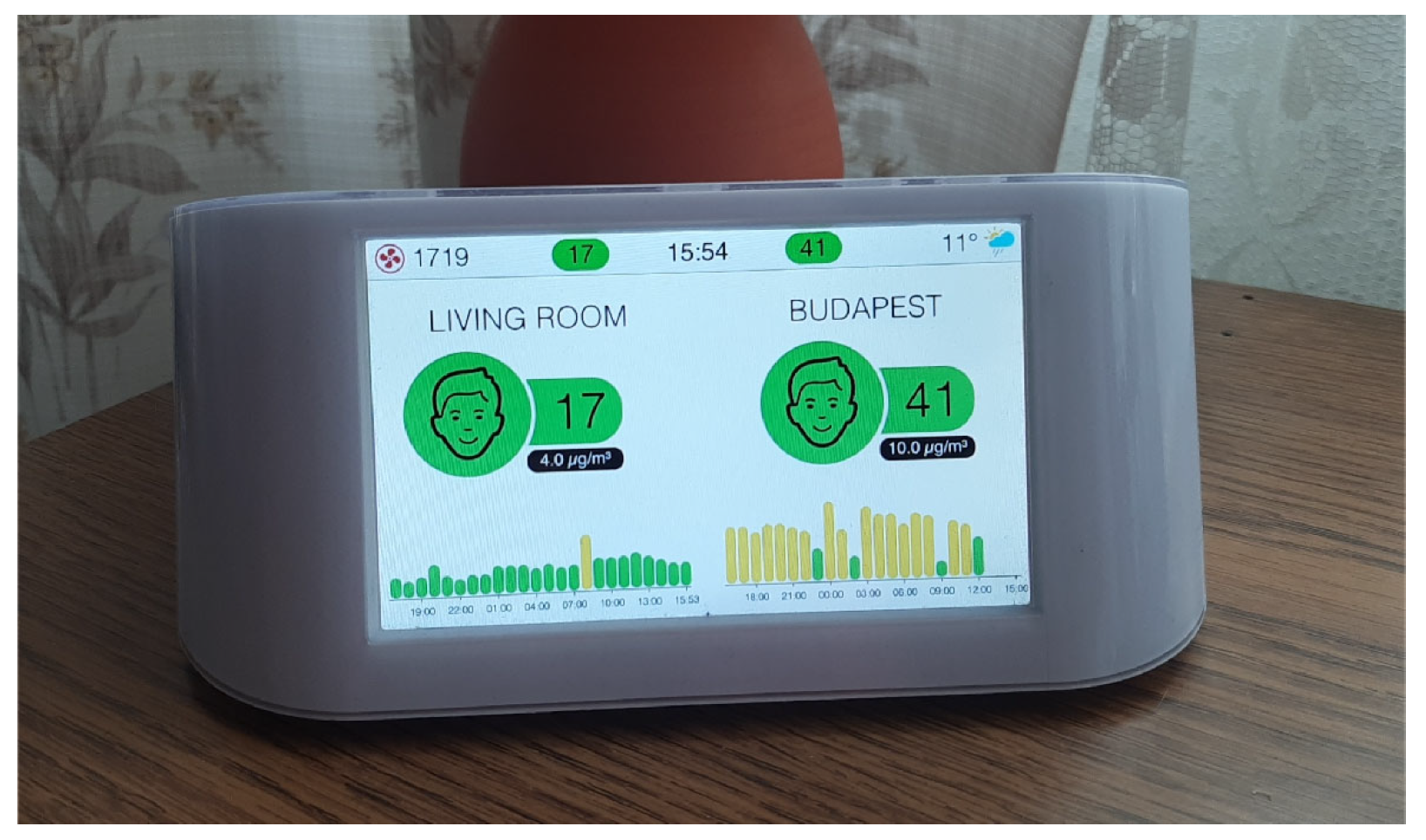
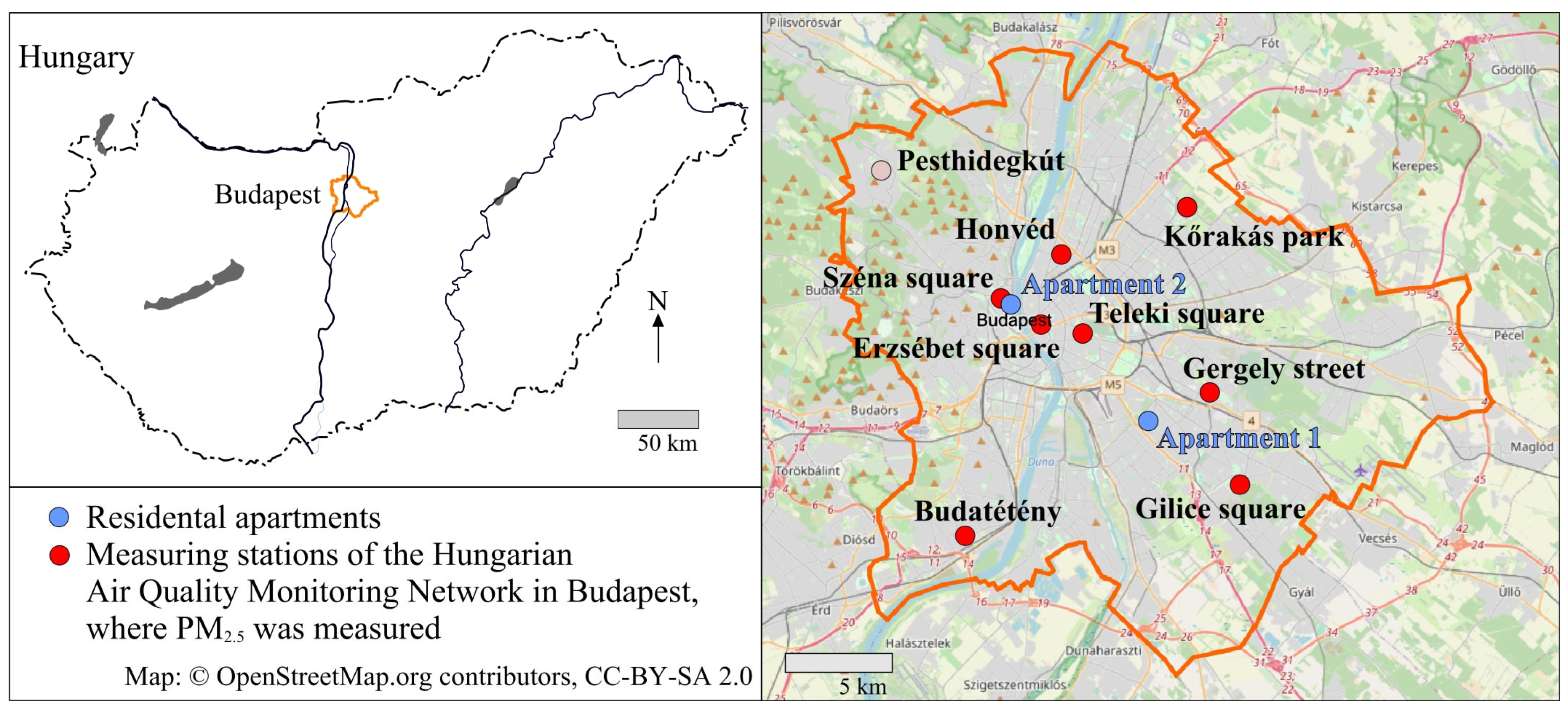
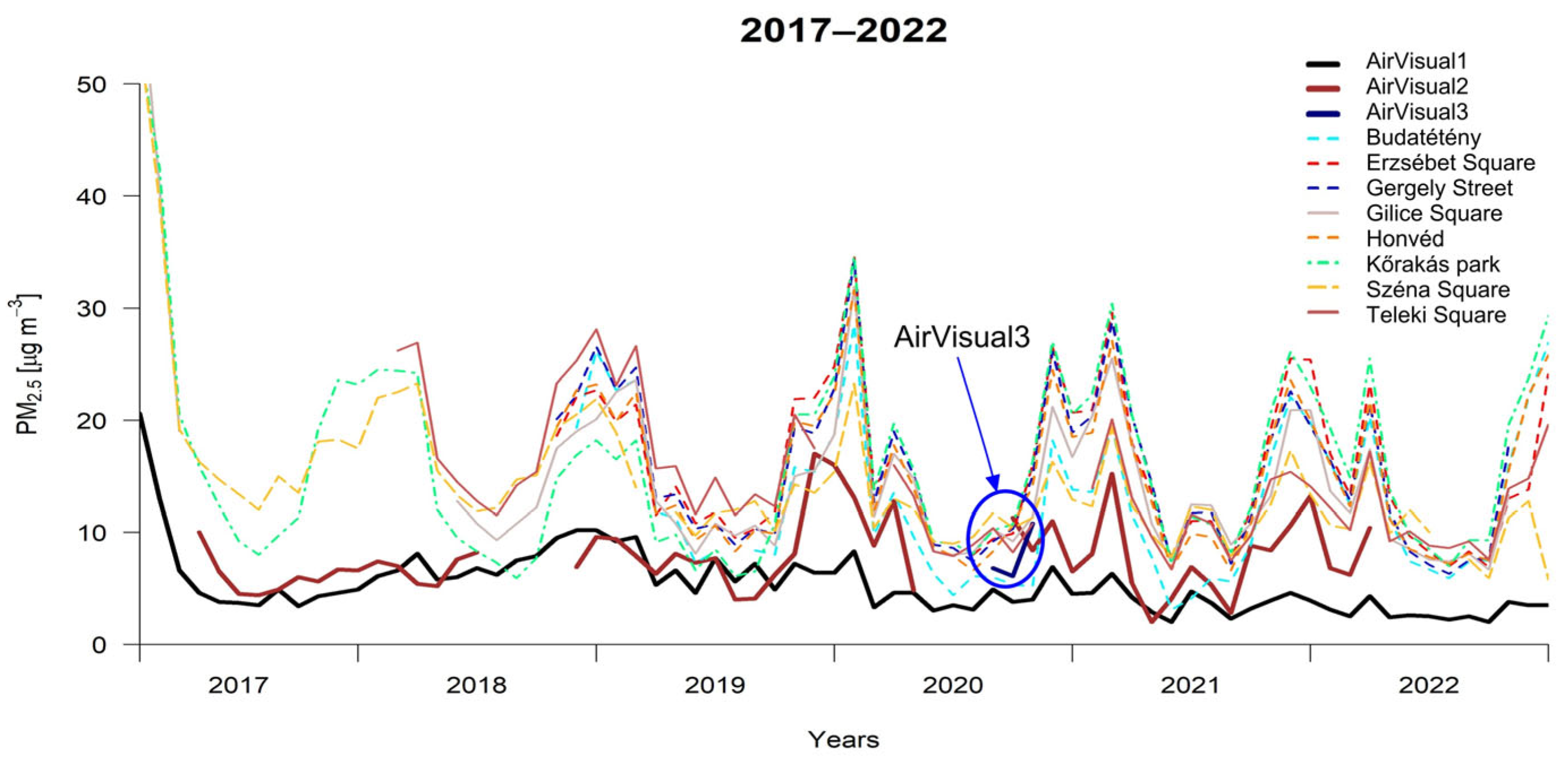



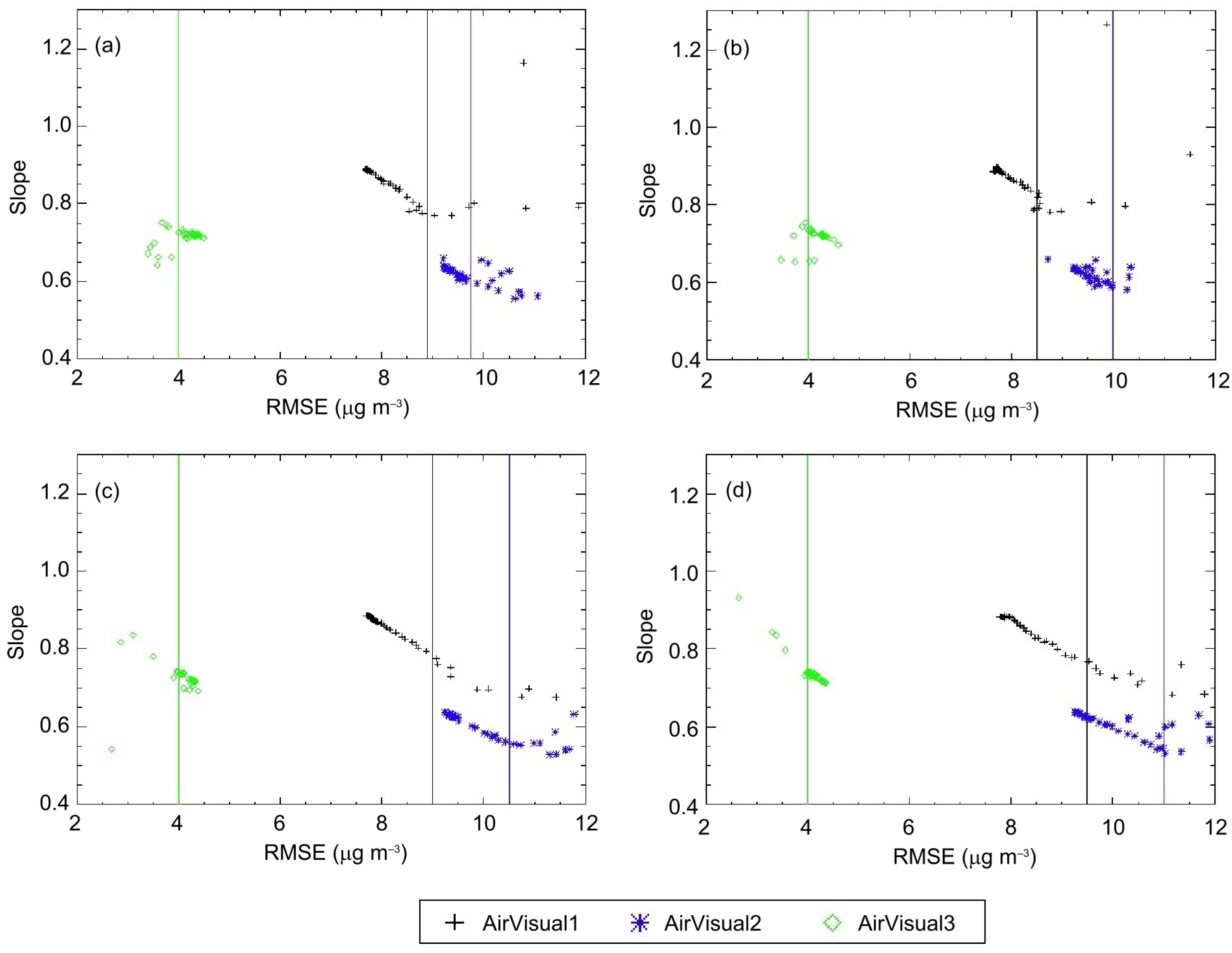

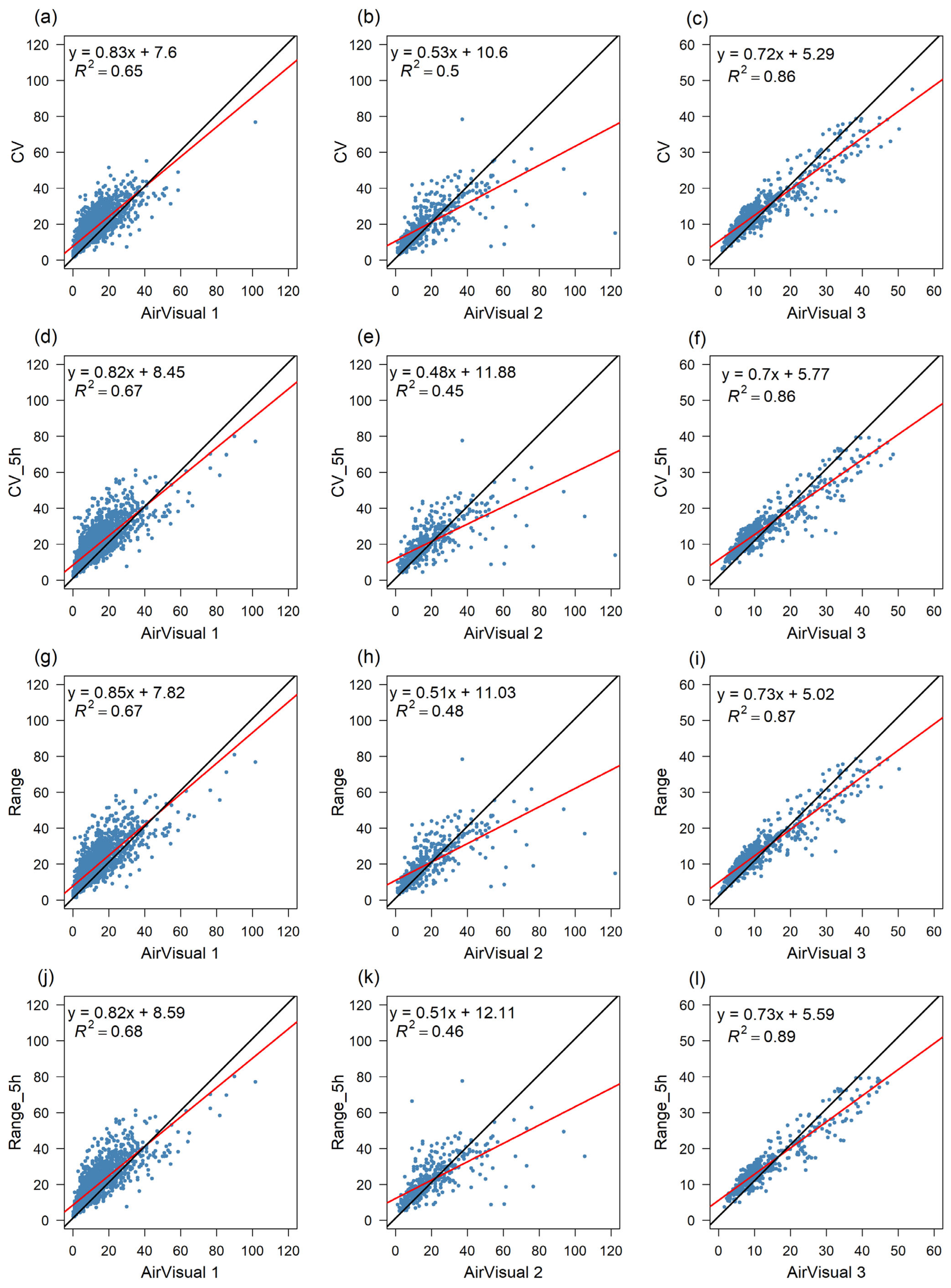

| Site No | Total Size | Floor | No. of Rooms | No. of Residents | Heating System | Cooling System | Type of Ventilation |
|---|---|---|---|---|---|---|---|
| Apartment 1 (AirVisual 1) | ~50 m2 | 0 | 2 | 4 | Central heating system | Air conditioner in the kitchen | Windows opened 3–4 times a day |
| Apartment 2 (AirVisual 2) | 78 m2 | 4 | 4 | 4 | Central heating system | No cooling system | Windows opened 2 times a day |
| Apartment 1 storage room (AirVisual 3) | ~5 m2 | 0 | 1 | 0 | No heating system | No cooling system | Natural (open window conditions) |
| PM2.5 Concentration (Average ± Standard Deviation in μg m–3) | |||||
|---|---|---|---|---|---|
| Station | Spring (MAM) | Summer (JJA) | Autumn (SON) | Winter (DJF) | Yearly |
| Budatétény | 10.1 ± 7.5 | 6.3 ± 3.1 | 13.7 ± 10 | 19.4 ± 14.2 | 12.8 ± 11.0 |
| Erzsébet Square | 13.8 ± 8.4 | 9.3 ± 4.4 | 17.1 ± 10.8 | 22.2 ± 14.6 | 16.0 ± 11.5 |
| Gergely Street | 12.4 ± 8.4 | 8.9 ± 4.5 | 16.9 ± 11.1 | 21.9 ± 15.4 | 15.4 ± 11.9 |
| Gilice Square | 12.8 ± 8.3 | 9.7 ± 4.8 | 14.0 ± 9.2 | 24.6 ± 22.0 | 15.0 ± 13.7 |
| Honvéd | 12.4 ± 8.4 | 8.4 ± 3.9 | 17.0 ± 10.9 | 20.9 ± 13.9 | 14.9 ± 11.1 |
| Kőrakás Park | 14.2 ± 10.1 | 8.5 ± 4.7 | 17.3 ± 11.7 | 25.1 ± 18.8 | 16.3 ± 13.7 |
| Széna Square | 13.3 ± 7.1 | 11.6 ± 5.3 | 14.0 ± 7.9 | 18.9 ± 16.9 | 14.5 ± 10.7 |
| Teleki Square | 13.7 ± 8.7 | 10.8 ± 5.0 | 15.5 ± 10.0 | 23.3 ± 20.8 | 15.4 ± 12.9 |
| AirVisual 1 | AirVisual 2 | AirVisual 3 | |
|---|---|---|---|
| All cases | 8124 | 1607 | 2421 |
| At least six stations available | 6480 | 1047 | 2398 |
| At least six stations available for 5 h | 6391 | 1030 | 2338 |
Disclaimer/Publisher’s Note: The statements, opinions and data contained in all publications are solely those of the individual author(s) and contributor(s) and not of MDPI and/or the editor(s). MDPI and/or the editor(s) disclaim responsibility for any injury to people or property resulting from any ideas, methods, instructions or products referred to in the content. |
© 2025 by the authors. Licensee MDPI, Basel, Switzerland. This article is an open access article distributed under the terms and conditions of the Creative Commons Attribution (CC BY) license (https://creativecommons.org/licenses/by/4.0/).
Share and Cite
Mészáros, R.; Barcza, Z.; Atfeh, B.; Hollós, R.; Kristóf, E.; Tordai, Á.V.; Groma, V. Quantification of the Spatial Heterogeneity of PM2.5 to Support the Evaluation of Low-Cost Sensors: A Long-Term Urban Case Study. Atmosphere 2025, 16, 998. https://doi.org/10.3390/atmos16090998
Mészáros R, Barcza Z, Atfeh B, Hollós R, Kristóf E, Tordai ÁV, Groma V. Quantification of the Spatial Heterogeneity of PM2.5 to Support the Evaluation of Low-Cost Sensors: A Long-Term Urban Case Study. Atmosphere. 2025; 16(9):998. https://doi.org/10.3390/atmos16090998
Chicago/Turabian StyleMészáros, Róbert, Zoltán Barcza, Bushra Atfeh, Roland Hollós, Erzsébet Kristóf, Ágoston Vilmos Tordai, and Veronika Groma. 2025. "Quantification of the Spatial Heterogeneity of PM2.5 to Support the Evaluation of Low-Cost Sensors: A Long-Term Urban Case Study" Atmosphere 16, no. 9: 998. https://doi.org/10.3390/atmos16090998
APA StyleMészáros, R., Barcza, Z., Atfeh, B., Hollós, R., Kristóf, E., Tordai, Á. V., & Groma, V. (2025). Quantification of the Spatial Heterogeneity of PM2.5 to Support the Evaluation of Low-Cost Sensors: A Long-Term Urban Case Study. Atmosphere, 16(9), 998. https://doi.org/10.3390/atmos16090998







